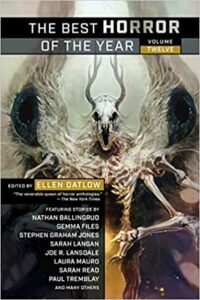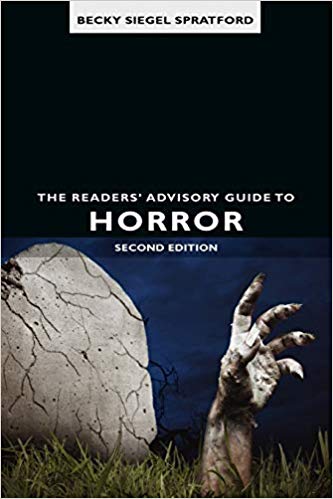 ( Bookshop.org | Amazon.com )
( Bookshop.org | Amazon.com )
The Best Horror of the Year, Volume 12, edited by Ellen Datlow
Night Shade Books, 2020
ISBN: 9781597809733
Available: Paperback, Kindle edition
The Best Horror of the Year anthologizes short stories by a variety of writers, previously published during 2019, chosen by well-known editor Ellen Datlow. It is an almost even mix of excellent, decent, and forgettable stories: out of the 22 stories, seven are outstanding, seven are skippable, and the other eight are satisfactory, middle-of-the-road stories.
The majority of the stories are written from a first person point of view. Of the stories written in the third person, many of them are written in the present tense. This book is best suited for those who like variety, both in story ideas and writing style. Readers who prefer third person narratives in the past tense may not find what they’re looking for, but everyone else will probably find something here to enjoy. Let’s take a look at some of the best ones:
Scariest: “The Hope Chest” by Sarah Read and “The Puppet Motel” by Gemma Files are both winners that get genuinely creepy right towards the end. The first one is a bizarre story of a dead grandmother returning (sort of) through a dress form. The second is a wonderfully chilling story of a rental room that may have access to another dimension. Like “The Hope Chest”, it piles on the scare factor at the end. The best in the book for true fear is “My Name is Ellie” by Sam Rebelein. It has the classic cabin in the woods, but this is beyond any other one you have read. Little people, human sacrifices, body parts… they all contribute to the terror. This is the one to keep you awake at night when you hear the house creak.
Most Unusual: “I Say (I Say I Say)” by Robert Shearman. Remember all the jokes you heard growing up concerning an Englishman, a Scotsman, and an Irishman? This turns those joke personalities into actual people who live on a different plane of existence, and get summoned from time to time to perform the jokes we all know. It’s not scary, but it’s very original, and very good.
Best Thrill Rides: “The Senior Girls Bayonet Drill Team” by Joe R. Lansdale and “The Butcher’s Table” by Nathan Ballingrud. The first one makes a story out of the girls’ team’s bus ride to their next match, where the object is to kill the opposing team members with bayonets. This is a nice portrayal of psychology where each game played may be the last, and puts a twist on the craziness of high school sports. “The Butcher’s Table” is the longest story, and possibly the most overall fun. Set in the 1800s, it concerns pirates escorting Satan worshippers across the Caribbean to the shores of Hell, where they plan to dine with Satan. So silly that it’s great fun, and it’s nice to finally have a horror story with pirates, as they are a character type that is rarely used anymore.
Best Thriller and Chiller: “Below” by Simon Bestwick. This story about two young English lads who fall into a pseudo-town below the Earth’s crust brings out the claustrophobic feelings that films like The Descent tapped into so well. The scare factor is there, but it’s also just flat-out exciting as the two boys race through the underground trying desperately to find an escape. This is possibly the most well-rounded story out of the collection.
The stories above probably make the book worth the price of admission, and there are still the eight perfectly reasonable stories not covered here to go with it. It’s enough to overlook the seven stories that simply don’t cut it. Editor Ellen Datlow also provides a detailed summary of the horror fiction genre and awards winners of 2019. The Best Horror of the Year, Volume 12 will be a good addition for most horror readers to add to their collection, and a good purchase for libraries wanting to keep current on the trends and authors at the top or rising to the top of the horror genre.
Contains: violence, profanity
Reviewed by Murray Samuelson





Follow Us!